Key Points:
- Like giraffes, dinosaurs used their long necks to consume plant life high in trees.
- The neck of the Isisaurus was long and also extremely thick when compared to other long-necked dinosaurs.
- The Mamenchisaurus grew to a length of about 65 feet (19.8 meters) and a height of 35 feet (10.6 meters). Its neck was extremely long and made up most of its length.
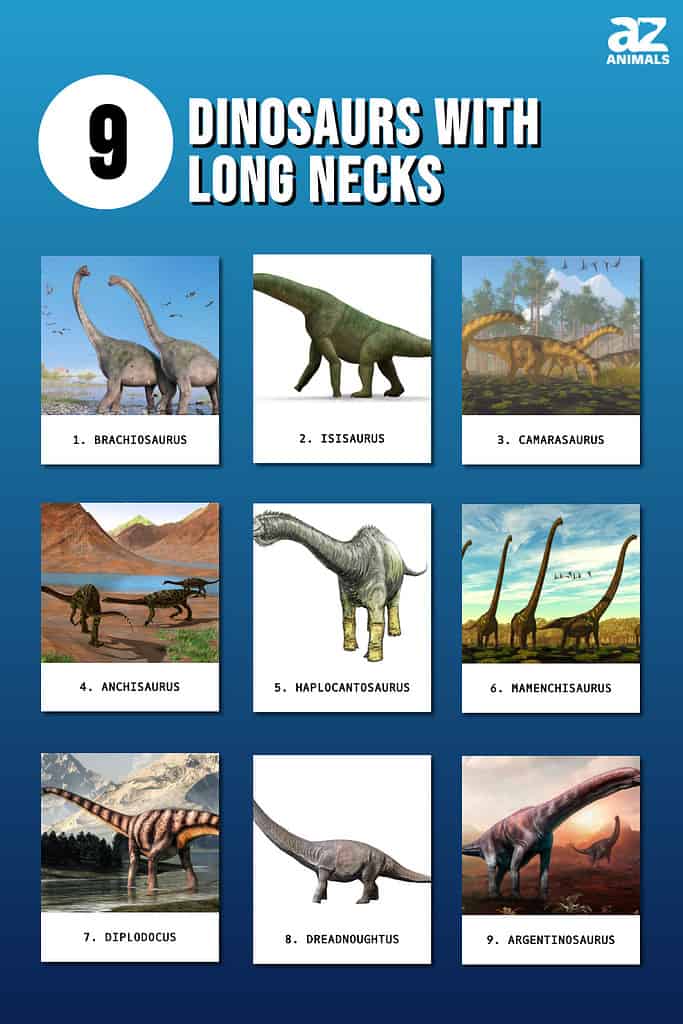
Millions of years ago, dinosaurs were abundant on the earth, and one common type was the sauropod. These dinosaurs had some of the longest necks in history and are also among the largest animals to ever walk the earth. Currently, the male giraffe is the animal with the longest neck.
In this article, you will learn about 10 dinosaur species that had some of the longest necks ever, some of which are much larger than the giraffes we see today.
Like giraffes, dinosaurs used their long necks to feed on plant life high in the trees and support their herbivorous lifestyles. The first sauropods came into existence during the early Jurassic Epoch period, and they existed millions of years later. The dinosaurs on this list and other giants that lived millions of years ago are among the largest animals to ever exist, before going fully extinct.
1. Brachiosaurus

Brachiosaurus lived during the Late Jurrasic Period in what is now North America.
©iStock.com/dottedhippo
Brachiosaurus lived during the Late Jurrasic Period in what is now North America. Their neck was long like other sauropods, and each vertebra was 3 feet (1 meter) long. Brachiosaurus stood 39 feet tall (12 meters) and had a body 75 feet long (23 meters). Brachiosaurus is estimated to have weighed as much as 40 tons (40,000 Kilograms).
This dinosaur and other sauropods have had similar traits to each other such as:
- Long necks and tail
- Walking on all fours
- A herbivorous diet
- Small heads and tiny brain
The tall neck of the Brachiosaurus helps reach the leaves in the tallest of trees. Living in herds, food was a major motivator in getting the herd to travel. While it is impossible to know the true lifespan of the Brachiosaurus, paleontologists estimate them to live around 100 years.
2. Isisaurus

The Isisaurus lived in India during the Cretaceous Period and is the closest dinosaur species to the modern giraffe.
©Ansh Saxena, CC BY-SA 4.0 <https://creativecommons.org/licenses/by-sa/4.0>, via Wikimedia Commons – License
A large sauropod dinosaur that lived during the Cretaceous Period is the Isisaurus. This dinosaur lived in India, and its fossils are some of the most complete among Titanosuaria. The Isisaurus is estimated to have a large length of around 59.1 feet (18 meters). The fossil of this species is nearly complete, and they are one of the closest dinosaur species to modern-day giraffes in appearance.
The neck of the Isisaurus was long and stuck out more forward instead of vertically. This species’ neck was also extremely thick when compared to other long-necked dinosaurs. Their legs were long, but the incomplete fossils discovered are not enough to know how large they were capable of growing. Grasslands, forests, and wetland-type habitats are some of the areas they may have lived.
3. Camarasaurus

The Camarasaurus is one of the most common dinosaurs that left behind fossils from the Jurrasic Period.
©Catmando/Shutterstock.com
Living in North America, Camarasaurus is one of the most common dinosaurs to find. Fossils of this species have been continually discovered since 1877, with specimens being dug up across the United States. Four species of Camarasaurus exist which are C. supremus, C. grandis, C. lentus, and C. lewisi.
These dinosaurs are not the largest of sauropods, and they grow to be around 50 to 65 feet long (15 to 20 meters). Standing at around 20 feet tall (6 meters), it is estimated they weighed around 20 tons (40000 lbs). The Camarasaurus diet mainly consisted of conifers since that was the dominant plant of their time. To reproduce like other dinosaurs, Camarasuars laid eggs and have also left some egg fossils behind. To increase survivability, they traveled together in groups with other Sauropods.
4. Anchisaurus
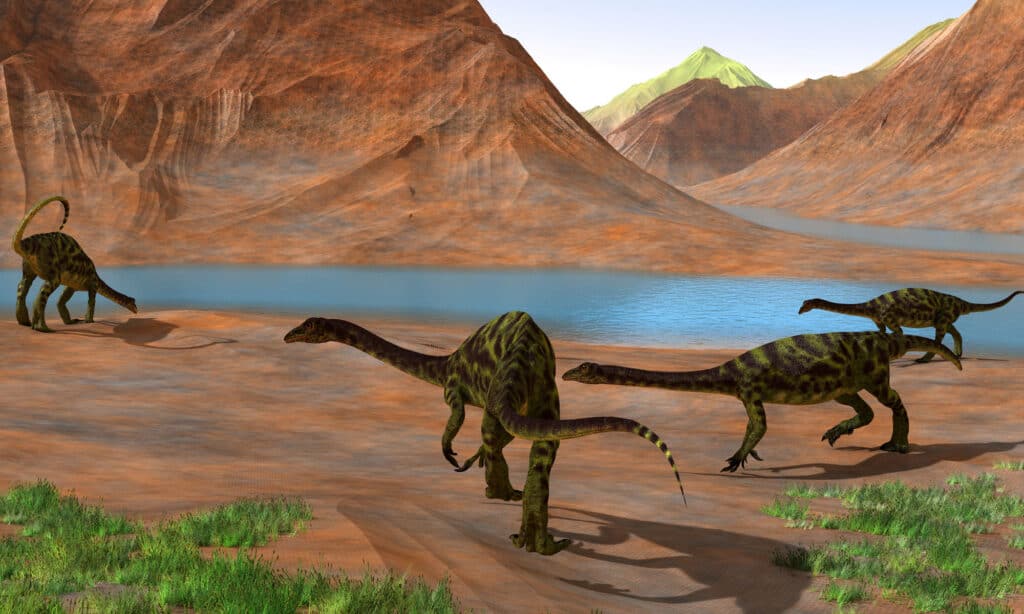
The Anchisaurus lived in North America, with fossils discovered in Canada, Nova Scotia, Connecticut, and Arizona.
©iStock.com/CoreyFord
The Anchisaurus walked the earth from 150 to 144 million years ago in the late Jurrasic Period. This species lived in North America, with its fossil discovered in Nova Scotia, Canada, Connecticut, and Arizona. Anchisaurus are sauropods but much smaller than some of their relatives. Unlike other sauropods, they are capable of walking on both two and four legs.
The Anchisaurus has a length of between 6.6 to 13 feet (2.011 meters), and they weigh around 60 lbs (27.2 kgs). Plants were what this species survived off mostly, but they occasionally ate meat.
5. Haplocantosaurus

Haplocantosaurs was able to grow more than 49 feet in length.
©FunkMonk (Michael B. H.), CC BY-SA 3.0 <https://creativecommons.org/licenses/by-sa/3.0>, via Wikimedia Commons – License
Haplocantosaurus is a Sauropod dinosaur that lived in North America around 157 to 153 million years ago. Fossils of the Haplocantosaurus have been discovered in Colorado and Wyoming. Haplocantosaurus are able to grow more than 49 feet in length (14.8 meters). Originally this dinosaur was named Haplocanthus, but this was changed since the name was close to another animal.
Only four fossils of these dinosaurs have been discovered, and they are all incomplete. The Haplocantosaurs likely weighed up to 25 tons, and being so large, they needed a large amount of food to feed their herbivorous diet. Ferns most likely made up a large portion of this dinosaur’s diet since these plants were abundant during the Jurrasic period.
6. Mamenchisaurus
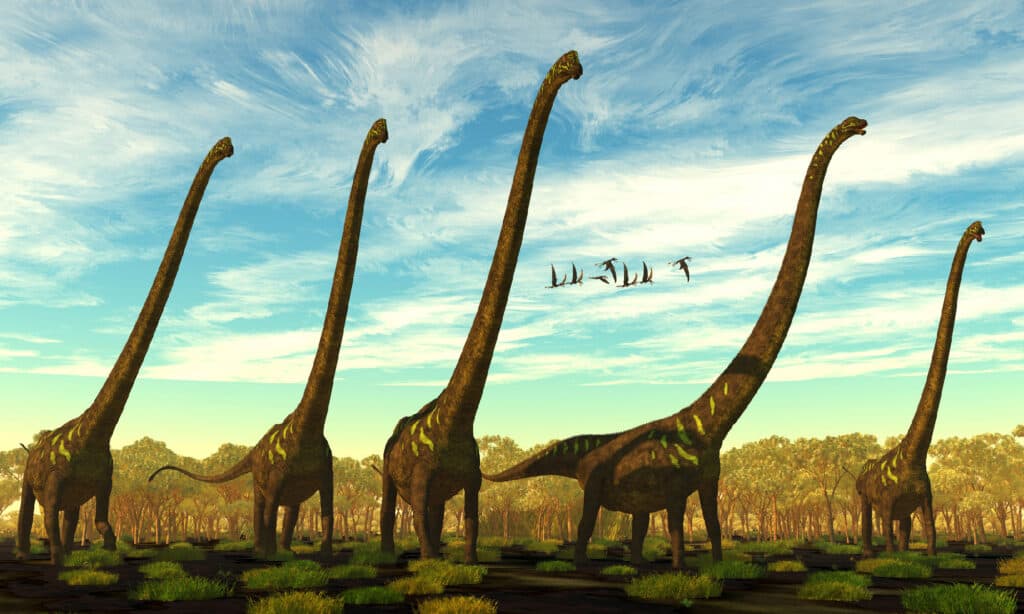
The neck of the Memenchisaurs is extremely large and is bigger than a scho
ol bus.©iStock.com/CoreyFord
The Mamenchisaurus are sauropod dinosaurs that lived in Asia during the Jurassic period. Fossils of this species have been discovered in China and Mongolia. There are around 6 species in the genus of Memenchisaurus, but this may change over time as more fossil evidence is discovered in the future.
These dinosaurs grow to a length of about 65 feet (19.8 meters) and a height of 35 feet (10.6 meters). Their neck is extremely long and makes up most of their length. This dinosaur has similar traits to other sauropods, like walking on all fours and being a herbivore.
7. Diplodocus
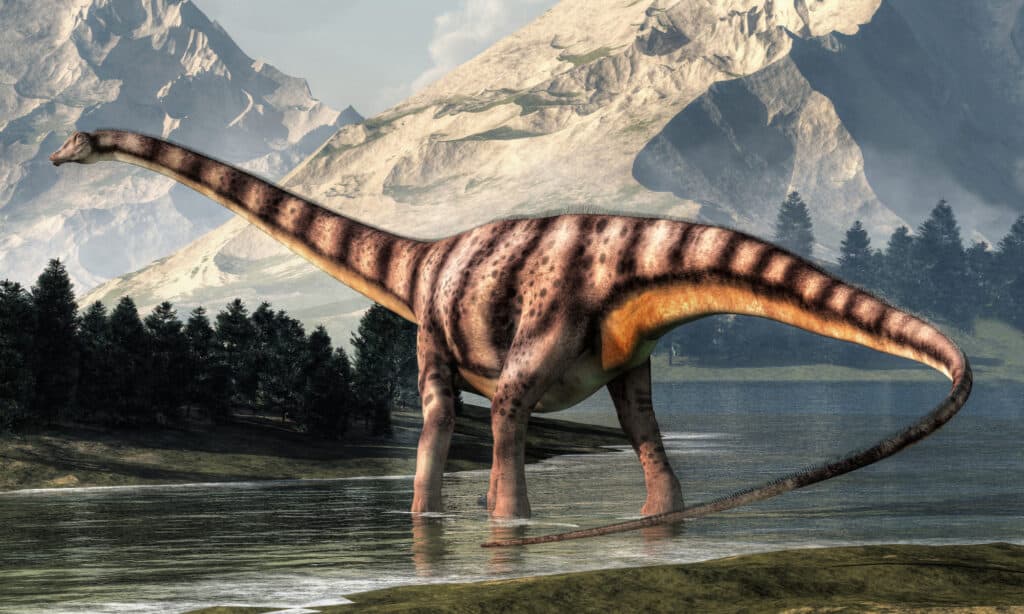
The head of the Diplodocus is only around two feet.
©Daniel Eskridge/Shutterstock.com
Weighing around 33069 lbs(15000 kilograms), the Diplodocus is one of the largest animals to ever walked the earth. This dinosaur had a long neck, walked on all fours, and had a whip-like tail. This species lived in the United States during the Late Jurassic period. Roaming 155 to 145 million years ago, fossils have been discovered in Colorado, Montana, Utah, and Wyoming. The Diplodocus is a very common fossil, with more than 100 different specimens being discovered. Their head is an extremely rare find, as it was small and only around 2 feet (0.6 meters).
Being so large helped these herbivores eat from the many tall trees during the Jurassic period. Their teeth were comb-like and made it easy to plush leaves from trees. All together with the neck and tail, they had a length of around 85 feet (26 meters). They were not the heaviest of sauropods, and they weighed around 11 tons.
8. Dreadnoughtus

Dreadnoughtus is named after the giant Dreadnought battleship.
©Nobu Tamura email:[email protected] http://spinops.blogspot.com / CC BY-SA 4.0 – License
Dreadnoughtus is a type of titanosaurian sauropod and lived from the Late Jurassic period until the extinction of the dinosaurs. These species are among the largest animals to walk the earth and have a length of around 85 feet (26 meters). Walking on all fours, they carried a large mass of approximately 65 tons (130000 lbs). Dreadnoughtus inhabited Argentina and other areas in South America.
The large size of this dinosaur is what gives its name Dreadnoughtus. Being so large, they would have been almost untouchable, as they are much larger than most predatory species. Their large tail and neck made them dangerous to provoke. Sauropods inhabited forests with large and plentiful trees to be able to feed their enormous appetite. Most titanosaurian fossils are incomplete, but the Dreadnougtus has the most complete fossil of any species, with around 70% of its skeleton recovered.
9. Argentinosaurus
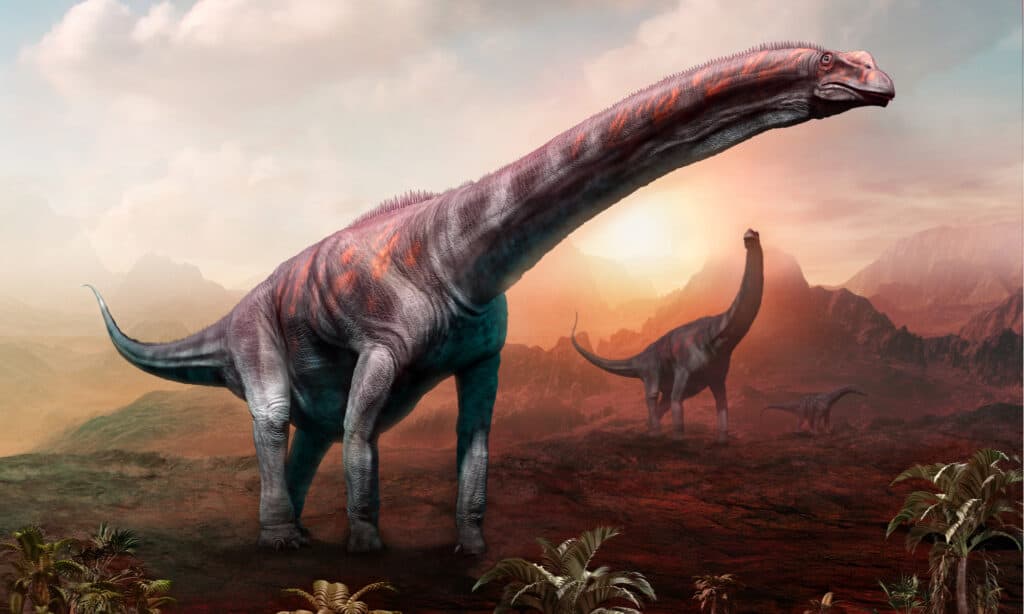
The Argentiosaurus is known as the largest dinosaur in the world.
©Warpaint/Shutterstock.com
Towering overall, the Argentinosaurus is the largest dinosaur ever to be discovered. This sauropod is a type of titanosaur, which are some of the largest dinosaurs ever to exist. Argentinosuarus are named after their discovery site, which was on a ranch in Argentina. Discovered in 1987, 13 fossilized bones are how we know this enormous species once walked the earth.
This large sauropod is estimated to grow 98 to 130 feet long (29 to 39 meters) when fully grown. Much taller than your average giraffe, the Argentinosaurus looked down 70 feet above everyone. This dinosaur is almost the heaviest to ever be discovered and weighed between 110,000 to 220,000 lbs (49895.1 to 99790.3 kilograms). Computer generations using the fossil evidence left behind is how this species gets its depictions.
Summary of the 9 Dinosaurs with Long Necks
| Rank | Dinosaur |
|---|---|
| 1 | Brachiosaurus |
| 2 | Isisaurus |
| 3 | Camarasaurus |
| 4 | Anchisaurus |
| 5 | Haplocantosaurus |
| 6 | Mamenchisaurus |
| 7 | Diplodocus |
| 8 | Dreadnoughtus |
| 9 | Argentinosaurus |
Bonus: Dinosaurs with Long Necks!
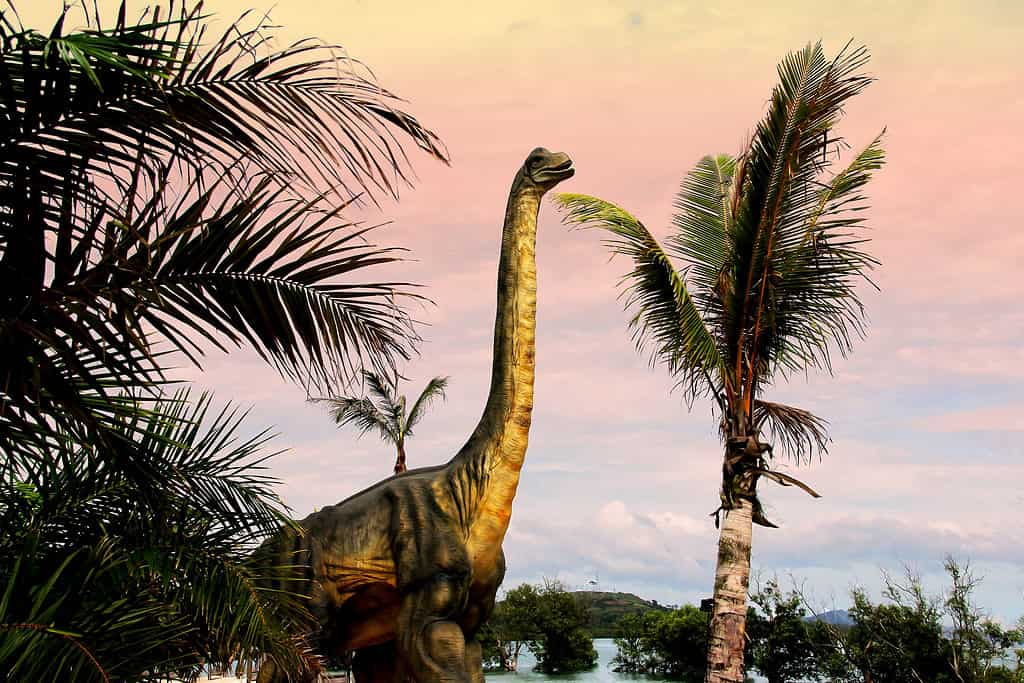
Sauropods are characterized by long tails, long necks, and small heads.
©thaloengsak/Shutterstock.com
Here are other dinosaurs that didn’t make the list with long necks:
- Sauropoda
- Apatosaurus
- Camarasaurus
- Omeisaurus
Sauropoda, also called sauropods, were a group of long-necked dinosaurs with long tails, small heads, and four strong, pillar-like legs. Some species within this group are famous for reaching enormous sizes, with some of them being the largest animals to ever walk on land!
While the Brontosaurus and the Apatosaurus are similar in look and size, scientists conclusively demonstrated that the Brontosaurus was a separate genus from the Apatosaurus. One of the primary distinctions was that Apatosaurus had a more massive and robust build, along with a thicker, lower-set neck compared to Brontosaurus.
Additionally, the Camarasaurus belonged to the group of herbivorous, four-legged dinosaurs and holds the distinction of being the most frequently found sauropod fossil in North America. These amazing creatures were also known for their extraordinarily long necks.
Furthermore, Omeisaurus, a sauropod dinosaur genus, originated during the Middle Jurassic Period in what is now present-day China. Its name is derived from its discovery site at Mount Emei, located in the lower Shaximiao Formation of Sichuan Province. It’s known for its long neck and large size.
The photo featured at the top of this post is © iStock.com/CoreyFord
Thank you for reading! Have some feedback for us? Contact the AZ Animals editorial team.






